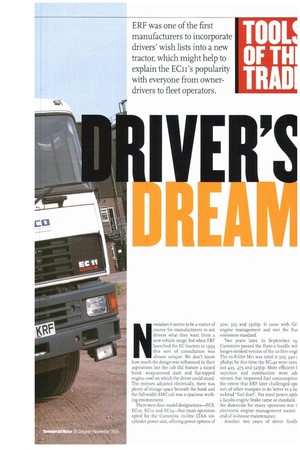VER'S
Page 29

Page 31

If you've noticed an error in this article please click here to report it so we can fix it.
Nowadays it seems to be a matter of course for manufacturers to ask drivers what they want from a new vehicle range, but when ERE launched the EC tractors in 1993 this sort of consultation was almost unique. We don't know how much the design was influenced by their aspirations but the cab did feature a raised bunk, wrap-around dash and flat-topped engine cowl on which the driver could stand. The mirrors adjusted electrically, there was plenty of storage space beneath the bunk and the full-width S MC cab was a spacious working environment.
There were four model designations—EC8, ECio, ECI2 and F.Cr4—hut most operators opted for the Cummins ro-litre LTAA sixcylinder power unit, offering power options of
300, 325 and 35ohp. It came with Ce] engine management and met the Eui emissions standard.
Two years later, in September 19 Cummins passed the Euro-2 hurdle wit longer-stroked version of the to-litre engi The tog-litre Mn was rated at 305, 340 z 38ohp; by this time the ECT4s were turn Out 42,5, 475 and 525hp. More efficient f injection and combustion were ad( virtues that improved fuel consumptior the extent that ERF later challenged opt tors of other marques to do better in a he to-head "fuel duel". For most power optit a Jacobs engine brake came as standard, the downside for many operators was t electronic engine management meant end of in-house maintenance.
Another two years of driver feedh
prompted further changes to the cab. Lowering the dash improved forward vision; more space was engineered into the footwell; the seating was improved and a more efficient heating system was introduced.
However, the three levels of cab trim— Standard, LX and Olympic—remained. The darker trim got just as dirty as before; it just didn't look as bad.
The LX featured tinted glass, rubber floor mats, a carpeted engine cover, adjustable steering column, electric passenger window, tinted glass roof vent and external temperature gauge.
A new catwalk giving better access to the back of the cab also served to tidy up the chassis, and a much larger silencer was mounted transversely behind the cab.
ERF embraced metrication. The capacity of the rectangular fuel tanks was in litres rather than gallons, and metric brake pipes and fittings were used for the first time, along with brake silencers.
Eaton's 2.-s peed constant-mesh Twin Splitter transmission and the even older ninespeed range-change box were joined by an Eaton 16-speed synchromesh unit—in all cases the boxes were shielded to help the EC II comply with the 8odB(A) drive-by noise requirement.
As well as the basic 4x2 configuration, operators could opt for mid-lift, rear-lift or twinsteer 6xz chassis. In the autumn of 1996 a 6x4 option was added to the range. along with a 4o5hp power option complete with z.000Nm of torque at ezoorprn.
In the new millennium, with new owners and a new factory, ERF is still relying on the Cummins Mul. engine to power the latest composite-cabbed ECX and steel-cabbed ECS, with power options up to 44ohp.
• by Bib Brock












































































































